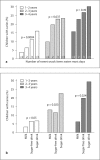Snacking habits and caries in young children
- PMID: 20720422
- PMCID: PMC2969163
- DOI: 10.1159/000318569
Snacking habits and caries in young children
Abstract
Dental caries is caused by a combination of infection and diet. This disease, if left untreated, may lead to pain, and impair the quality of life, nutritional status and development of young children. The objective was to investigate the association between snacking and caries in a population at high risk of dental caries. American preschool children (n = 1,206) were recruited in the offices of paediatricians. Data on sociodemographic characteristics, oral hygiene, breast-feeding, use of bottle and snacking were collected by questionnaire. Plaque presence, the number of teeth and their caries status (deft) were scored. The children sampled were 61% Black, 27% White and 10% Asian. Of the 1- to 2-, 2- to 3- and 3- to 4-year-old children, 93.8, 82.4 and 77.3% were caries free, and their mean caries scores were 0.16, 0.58 and 0.93, respectively. Multivariate partial least squares (PLS) modelling revealed plaque presence, lowest income, descriptors for tooth exposure time (number of teeth and age) and cariogenic challenge (total intake of sugar-containing snacks and chips/crisps, and chips intake with a sugar-containing drink) to be associated with more caries. These differences were also found in univariate analyses; in addition, children who continued breast-feeding after falling asleep had significantly higher deft values than those who did not. PLS modelling revealed that eating chips clustered with eating many sweet snacks, candies, popcorn and ice cream. We conclude that, in addition to the traditional risk indicators for caries - presence of plaque, sugar intake and socioeconomic status -, consumption of chips was associated with caries in young children.
Copyright © 2010 S. Karger AG, Basel.
Figures



Similar articles
-
Diet and caries experience among preschool children in Ajman, United Arab Emirates.Eur J Oral Sci. 2009 Dec;117(6):734-40. doi: 10.1111/j.1600-0722.2009.00688.x. Eur J Oral Sci. 2009. PMID: 20121938
-
Dietary determinants of dental caries and dietary recommendations for preschool children.J Public Health Dent. 2000 Summer;60(3):197-206; discussion 207-9. doi: 10.1111/j.1752-7325.2000.tb03328.x. J Public Health Dent. 2000. PMID: 11109219
-
Early feeding practices and severe early childhood caries in four-year-old children from southern Brazil: a birth cohort study.Caries Res. 2010;44(5):445-52. doi: 10.1159/000319898. Epub 2010 Sep 13. Caries Res. 2010. PMID: 20838043
-
Intake of sweet drinks and sweet treats versus reported and observed caries experience.Eur Arch Paediatr Dent. 2010 Feb;11(1):5-17. doi: 10.1007/BF03262704. Eur Arch Paediatr Dent. 2010. PMID: 20129028
-
Dietary determinants of dental caries and dietary recommendations for preschool children.Refuat Hapeh Vehashinayim (1993). 2003 Apr;20(2):8-23, 78. Refuat Hapeh Vehashinayim (1993). 2003. PMID: 12830489 Review.
Cited by
-
Snack food consumption among Bangladeshi children, supplementary data from a large RCT.Matern Child Nutr. 2020 Oct;16(4):e12994. doi: 10.1111/mcn.12994. Epub 2020 Mar 20. Matern Child Nutr. 2020. PMID: 32196968 Free PMC article. Clinical Trial.
-
The association of maternal smoking and other sociobehavioral factors with dental caries in toddlers: A cross-sectional study.Front Pediatr. 2023 Apr 3;11:1115978. doi: 10.3389/fped.2023.1115978. eCollection 2023. Front Pediatr. 2023. PMID: 37077335 Free PMC article.
-
Association between nocturnal breastfeeding and snacking habits and the risk of early childhood caries in 18- to 23-month-old Japanese children.J Epidemiol. 2015;25(2):142-7. doi: 10.2188/jea.JE20140097. Epub 2015 Jan 10. J Epidemiol. 2015. PMID: 25721070 Free PMC article.
-
Effect of Nutritional Habits on Dental Caries in Permanent Dentition among Schoolchildren Aged 10-12 Years: A Zero-Inflated Generalized Poisson Regression Model Approach.Iran J Public Health. 2016 Mar;45(3):353-61. Iran J Public Health. 2016. PMID: 27141498 Free PMC article.
-
Evaluation of a preventive program aiming at children with increased caries risk using ICDAS II criteria.Clin Oral Investig. 2013 Dec;17(9):2049-55. doi: 10.1007/s00784-012-0907-x. Epub 2012 Dec 16. Clin Oral Investig. 2013. PMID: 23242815
References
-
- Adair LS, Popkin BM. Are child eating patterns being transformed globally? Obes Res. 2005;13:1281–1299. - PubMed
-
- Alm A, Wendt LK, Koch G, Birkhed D. Prevalence of approximal caries in posterior teeth in 15-year-old Swedish teenagers in relation to their caries experience at 3 years of age. Caries Res. 2007;41:392–398. - PubMed
-
- American Academy of Pediatric Dentistry Definition of early childhood caries (ECC) Pediatr Dent. 2008;27:13.
-
- Azevedo TD, Bezerra AC, de Toledo OA. Feeding habits and severe early childhood caries in Brazilian preschool children. Pediatr Dent. 2005;27:28–33. - PubMed
-
- Beltrán-Aguilar ED, Barker LK, Canto MT, Dye BA, Gooch BF, Griffin SO, Hyman J, Jaramillo F, Kingman A, Nowjack-Raymer R, Selwitz RH, Wu T, Centers for Disease Control and Prevention (CDC) Surveillance for dental caries, dental sealants, tooth retention, edentulism, and enamel fluorosis: United States, 1988–1994 and 1999–2002. MMWR Surveill Summ. 2005;54:1–43. - PubMed
Publication types
MeSH terms
Substances
Grants and funding
LinkOut - more resources
Full Text Sources
Medical

